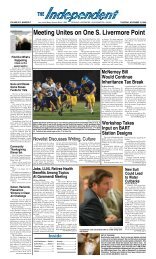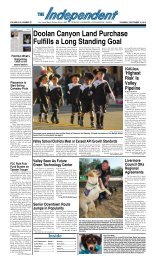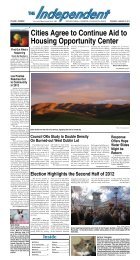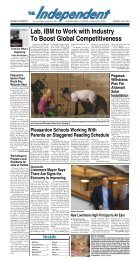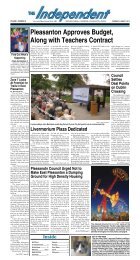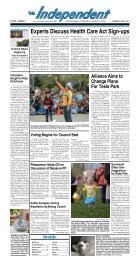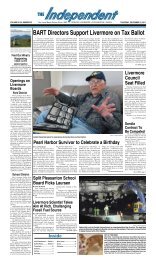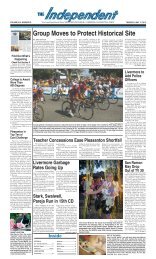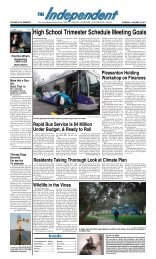Download - The Independent
Download - The Independent
Download - The Independent
You also want an ePaper? Increase the reach of your titles
YUMPU automatically turns print PDFs into web optimized ePapers that Google loves.
PAGE 12 - <strong>The</strong> <strong>Independent</strong>, JUNE 28, 2012<br />
Outing at the Ballpark Draws Attention to Juvenile Diabetes<br />
By Carol Graham<br />
For a 12-year-old taking<br />
the field at an Oakland A’s<br />
game, things can be a bit<br />
nerve-wracking.<br />
“Cody was nervous because<br />
of the large number<br />
of people he’d be in front<br />
of in the stadium along with<br />
the game being broadcast on<br />
television,” said mother Renee<br />
McCallister. “This was<br />
his first time at a baseball<br />
game. He didn’t know what<br />
to expect. He was surprised<br />
when he went onto the field<br />
and saw all of the players<br />
and heard the roar of the<br />
crowd.”<br />
Cody McCallister, a seventh-grader<br />
at Livermore’s<br />
Our Savior Lutheran School,<br />
was one of 12 participants<br />
from JDRF (formerly called<br />
Juvenile Diabetes Research<br />
Foundation; now known<br />
simply by its acronym),<br />
took the field to receive an<br />
autographed baseball from<br />
A’s center fielder Coco Crisp<br />
(formerly called Covelli<br />
Loyce Crisp; now known<br />
simply as Coco because, say<br />
his siblings, he resembles<br />
a character on the Cocoa<br />
Krispies cereal box.)<br />
To help raise money for<br />
JDRF, baseball players,<br />
coaches, celebrities and<br />
media personalities scooped<br />
root beer floats for fans prior<br />
to the June 20th game that<br />
saw the Oakland A’s beat<br />
the Los Angeles Dodgers<br />
4-1. Sugar-free root beer<br />
and ice cream were offered<br />
at special booths.<br />
“MUG Root Beer Float<br />
Day is a fun way for A’s fans<br />
to interact with players, to<br />
get autographs and photos,<br />
and to raise money for the<br />
charity,” said the A’s Senior<br />
Director of Marketing Troy<br />
Smith. “It’s a win-win!”<br />
JDRF is the leading global<br />
organization focused on<br />
Type 1 Diabetes, said the<br />
non-profit’s Special Events<br />
Coordinator Katy Coe. “Our<br />
goal is to improve the lives<br />
of every person affected<br />
by T1D by accelerating<br />
progress on the most promising<br />
opportunities for curing,<br />
treating and preventing<br />
T1D.”<br />
Type 1 Diabetes occurs<br />
when the body’s immune<br />
system destroys the insulinproducing<br />
beta cells of the<br />
pancreas.<br />
“It’s important to know<br />
that T1D cannot be prevented,<br />
you cannot outgrow<br />
it, and that insulin is not a<br />
Cody McCallister holds a baseball signed by A's<br />
outfielder Coco Crisp.<br />
cure,” said Coe. “All 12 kids<br />
who participated have Type<br />
1 Diabetes and are involved<br />
with JDRF either through<br />
our Outreach Program, as<br />
Cody is, or our Walk Ambassador<br />
Program.”<br />
<strong>The</strong> Outreach Program<br />
supports, engages, and connects<br />
the T1D community<br />
through family events, an<br />
extensive mentor program<br />
and educational toolkits.<br />
<strong>The</strong> Walk Ambassador<br />
Program is composed of<br />
nine young people who assist<br />
JDRF in educating the<br />
community about what it’s<br />
like living with T1D.<br />
“It was great to see my<br />
grandson Cody having such<br />
a great time with the Oakland<br />
A’s at the game Wednesday<br />
night,” said Kerry Taylor.<br />
“Cody and kids like him<br />
are learning to deal with<br />
T1D. <strong>The</strong>y all expect to live<br />
normal lives while they deal<br />
with the difficulties brought<br />
on by failing pancreas.<br />
“Treatment research may<br />
soon free them from the constant<br />
injections and the never<br />
ending struggle to balance<br />
their blood sugar.”<br />
JDRF categorizes its research<br />
in three main areas:<br />
Cure - Beta Cell <strong>The</strong>rapies<br />
(replacing or regenerating<br />
the beta cells that produce<br />
insulin), and Immune <strong>The</strong>rapies<br />
(preventing and reversing<br />
the immune system’s<br />
attack); Treat - Glucose Control<br />
<strong>The</strong>rapies (developing<br />
new devices and therapies,<br />
including artificial pancreas<br />
and insulin pump technologies)<br />
and Complications<br />
<strong>The</strong>rapies (stopping or reversing<br />
the progression of<br />
complications such as eye,<br />
nerve, or kidney disease);<br />
and Prevent - Research into<br />
the genetic and environmental<br />
causes of the disease.<br />
“<strong>The</strong> change in Cody’s<br />
life has been significant<br />
since the onset of diabetes,”<br />
noted Taylor. “Events like<br />
this and camps for kids with<br />
T1D have been the positive<br />
side of these adjustments.<br />
Cody is already becoming<br />
an example for the newly-diagnosed<br />
kids because of his<br />
determination to overcome<br />
whatever diabetes tries to<br />
take from him.”<br />
Over the 13 years that the<br />
A’s have hosted MUG Root<br />
Beer Float Day, which is<br />
sponsored by Pepsi and Dreyer’s,<br />
more than $350,000 has<br />
been raised for JDRF, said<br />
Smith. “From the very first<br />
year, the players, fans and<br />
JDRF embraced this event,”<br />
he added. “Root beer floats,<br />
summertime and baseball<br />
are a perfect match!”<br />
Zone 7 Directors<br />
Raise Potential for<br />
More Monthly Pay<br />
Zone 7 Water Agency<br />
directors voted to hold the<br />
line on the compensation<br />
they receive for each meeting<br />
in a month, but agreed to<br />
raise the cap on the number<br />
of compensated meetings<br />
per month.<br />
Directors took the action<br />
at their meeting June 20. <strong>The</strong><br />
vote was 6-1, with board<br />
president Sandy Figuers voting<br />
against the motion.<br />
Figuers agreed with other<br />
directors about freezing the<br />
amount of compensation at<br />
$159.99. He disagreed about<br />
which number should be<br />
chosen for the cap.<br />
<strong>The</strong> old policy was to cap<br />
compensation at four meetings<br />
per month. <strong>The</strong> new one<br />
will cap it at 10. Figuers said<br />
that six was a better number,<br />
and suggested the board<br />
could make upward adjustments,<br />
if necessary.<br />
In approving the policy,<br />
the directors also added<br />
language that defines a meeting.<br />
Meetings include the<br />
board’s regular meeting<br />
and any special meeting,<br />
board committee meetings,<br />
representation of Zone 7 at<br />
meetings of other agencies,<br />
and annual attendance at a<br />
meeting of statewide water<br />
districts.<br />
<strong>The</strong> board reviews its<br />
compensation every two<br />
years. Board members receive<br />
no benefits package.<br />
<strong>The</strong>ir only income, which<br />
directors consider to be more<br />
along the lines of a stipend to<br />
cover expenses, comes from<br />
their meeting pay.<br />
At the board’s meeting<br />
May 16, directors were in<br />
agreement about not raising<br />
their pay. <strong>The</strong>y cited the job<br />
hiring soft freeze for Zone<br />
7 staff, in which only essential<br />
positions are filled<br />
when they become vacant.<br />
Also, general manager Jill<br />
Duerig has declined a pay<br />
increase.<br />
However, several directors<br />
raised the possibility<br />
that some kind of monetary<br />
increase could lure more<br />
candidates into running for<br />
the board. <strong>The</strong>y won’t run<br />
for the money, but at least<br />
the agency would recognize<br />
rewarding more participation<br />
with enough to<br />
cover expenses and time and<br />
trouble.<br />
Also, some board members<br />
work in jobs where they<br />
must take time off from their<br />
duties, and may have to miss<br />
a half-day’s or a full day’s<br />
pay, directors noted. Child<br />
care cost were also cited in<br />
past discussions as something<br />
that might be offset by<br />
a change in compensation.<br />
BOARD PASSES<br />
CAPITAL BUDGET<br />
On another item, directors<br />
unanimously approved<br />
the capital improvement<br />
budget for $49.3 million for<br />
the fiscal year that begins<br />
July 1 and ends June 30,<br />
2013. <strong>The</strong> capital improvement<br />
budget varies from<br />
year to year, depending on<br />
which projects are being<br />
carried out by Zone 7.<br />
<strong>The</strong> board approved everything<br />
else in the Zone 7<br />
budget in April, because that<br />
part of the Zone 7 budget is<br />
part of the Alameda County<br />
budget. <strong>The</strong> sums approved<br />
at the June 20 meeting are<br />
for capital improvements<br />
only, and exclusive to Zone<br />
7.<br />
Because Zone 7 has been<br />
expecting to become totally<br />
independent from the county<br />
Jan. 1, 2013, staff had prepared<br />
an 18-month budget<br />
to cover the last six months<br />
of 2012, which is the last<br />
six months of the County’s<br />
July 1 to June 30 fiscal year,<br />
and the 12 calendar months<br />
next year.<br />
<strong>The</strong> 18-month budget<br />
would then enable zone 7 to<br />
prepare all its future budgets<br />
on calendar years, which is<br />
the period covered by the<br />
agency’s water rates.<br />
However, the enabling<br />
legislative bill for Zone 7 to<br />
gain total separation from<br />
the county was pulled. Zone<br />
7 plans to work further toward<br />
independence, but now<br />
won’t be able to achieve it<br />
County Concerned about State's Impact on Budget<br />
<strong>The</strong> Alameda County<br />
Board of Supervisors on<br />
Friday adopted a balanced<br />
budget that approved a $2.6<br />
billion spending plan and<br />
closed an $88.1M funding<br />
gap. Although this is the<br />
first funding gap of less than<br />
$100M in the past four years,<br />
cuts included eliminating 37<br />
vacant County positions and<br />
cuts to critical health and<br />
human services programs<br />
as a result of State-imposed<br />
reductions in funding those<br />
programs.<br />
Concerns remain in the<br />
county over the impact of<br />
trailer bills and the fate of<br />
the tax increase on the November<br />
ballot.<br />
“We hope that details<br />
emerging at the State level<br />
and the passage of the final<br />
budget bill don’t further negatively<br />
impact the county,”<br />
said County Administrator<br />
Susan S. Muranishi. “We’re<br />
already squeezed financially<br />
as a result of a protracted<br />
economic slump, with demand<br />
for safety net services<br />
remaining unusually high<br />
and the resources to pay for<br />
these services diminished.”<br />
<strong>The</strong> Legislature’s vote<br />
on the budget planned for<br />
Tuesday was postponed until<br />
at least Wednesday to allow<br />
time for members to review<br />
the trailer bill language,<br />
much of which is just now<br />
coming to light. Twenty<br />
trailer bills are expected.<br />
However, as of Tuesday only<br />
half of them have been made<br />
available for review. <strong>The</strong>se<br />
bills contain the details of<br />
implementing the plans contained<br />
in the budget, many of<br />
which significantly impact<br />
counties.<br />
Of particular concern to<br />
the county is the language<br />
that shifts over 80,000 lowincome<br />
children from the<br />
Healthy Families subsidized<br />
health care program to the<br />
lower-cost Medi-Cal plan,<br />
which health advocates say<br />
could cause some children to<br />
fall through the cracks due<br />
to issues with provider access.<br />
Many question whether<br />
this shift will yield the anticipated<br />
savings. Cuts to<br />
CalWORKs would reduce<br />
the length of time clients<br />
are able to receive grant<br />
payments from 48 to 24<br />
months. However, details<br />
are still still coming to light<br />
regarding implementation<br />
and allowable exemptions<br />
to the welfare-to-work requirement.<br />
“So many critical details<br />
are still emerging. Many<br />
of the proposed cuts affect<br />
the poorest members of our<br />
society.” said Supervisor<br />
Keith Carson, who chairs<br />
Alameda County’s Budget<br />
Workgroup.<br />
On top of that, there is<br />
the uncertain fate of the<br />
Governor’s package of taxincreases<br />
on the November<br />
ballot – which if not passed,<br />
could mean further reductions<br />
to programs important<br />
to local residents and leave<br />
a question mark related to<br />
guaranteed, ongoing funding<br />
for the State’s “realignment”<br />
plan which began last October.<br />
It transfers responsibili-<br />
ty for many public safety and<br />
health and human services<br />
programs from the State to<br />
local governments.<br />
“Realignment is taking<br />
us into uncharted territory,”<br />
said Supervisor Carson, “I<br />
believe it will be some time<br />
before we truly understand<br />
the full impact of these plans<br />
on Alameda County and the<br />
people we serve.”



